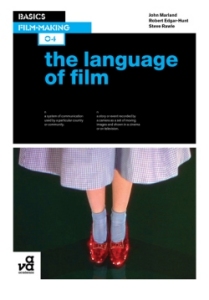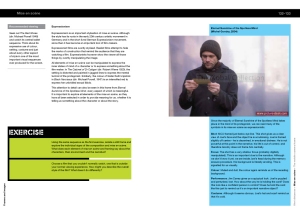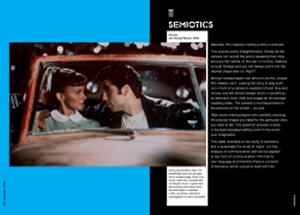
|
The world of non-commercial film and A-V |
Events Diary | Search | ||
| The Film and Video Institute | | ||||
| Basics Film-making: The Language
of Film
by Robert Edgar-Hunt, John Marland and Steven Rawle. |
 |
This is part of AVA Publishing's Academia imprint and is fourth in a series called Basics Film-making. The subject of this book, the language of film, is surprisingly complex. Since the early days of film, academics and critics have worked to understand and describe how audiences respond to and derive meaning from what they see on the screen. They have had to define a new type of grammar and vocabulary that at times has seemed impenetrable outside academic circles. This book is a distillation of these concepts.
 |
Despite the heavy subject matter, the book is slim and attractive with lots of film stills. It is obvious that a lot of thought has gone into the design and page layout. The aim of the authors is to help the reader learn how to understand the language of film either as a theoretician or to use in their own productions. To this end, each chapter has recommendations for further reading and film viewing; exercises; and a case study. Some of the case studies are short films conveniently available to view on the AVA website. The commercial films used as examples in the text cover all eras and genres from Battleship Potemkin (1925) to Pan's Labyrinth (2006). |
There are six chapters in all, headed Semiotics, Narrative, Intertextuality, Ideology, Frames and Images and Constructing Meaning. The authors summarise the main points of each topic and provide sign posts for the reader to delve deeper. I found some of the topics more amenable to concise summaries than others.
| Semiotics is the study of signs and their meanings. These are 'the most fundamental units of meaning - the atoms from which films are made'. A successful film-maker understands how to use signs to communicate with the audience, 'to steer their perception and focus their attention'. Signs provide a shorthand for complex notions that would otherwise require a lot of words. Even someone new to this idea can immediately recognise its validity and think of simple examples: a red rose can stand for love; a flag for a country or cause; red means danger; a character with crew cut, tie and briefcase looks responsible and traditional The case study for this chapter is Seven, a film full of innumerable signs. |  |
Despite its deceptively simple title, and the fact that narrative is fundamental to our lives, this reviewer struggled with the Narrative chapter. The analysis and study of narrative is traced back as far as Aristotle and the summary presented here can simply act as a catalyst to further studies.
Intertextuality (a word that my Spellchecker refuses to recognise) is the idea that art builds on what has gone before. 'All films tap into a shared cultural heritage and emerge from a web of pre-existing materials and expressive forms.' The discussion in this chapter ranges from films that explicitly reference other films, such as the government employees in Brazil secretly watching Casablanca; to the way categorisation of films into genres sets the audience's expectations; to the use of cultural references, for example religion and philosophy in The Matrix.
The authors begin the Ideology chapter with 'Ideology is a difficult and slippery term', which is a bit daunting, but they lead us gently into the theme pointing out that none of us is free from a personal ideology. We all have a set of beliefs, and a social and cultural position that shape the way we interpret a film and the way we would present a world view if we were to make a film. This chapter explores propaganda and realism including the extreme realist movement Dogme 95 established in Denmark by Lars von Trier and Thomas Vinterberg.
Frames and Images is a very accessible chapter covering the perspective of shots - distance, height, angles, depth of field and movement. It also touches on framing, lighting, expressionism, mise en scene and duration. I found all these a rich source of inspiration for further study.
Constructing Meaning describes the evolution and key features of the dominant mode of editing (continuity editing) used today, also bringing in montage and sound editing.
While this book is written for students of film, it would be of interest to anyone who wishes to understand about film theory and how films communicate with audiences.
ISBN 978-2-940411-27-6
Published by AVA Publishing. (www.avabooks.com)
Price £19.95
(reviewed by Jan Watterson May 2010)
Share your passions.

Share your stories.